Two years ago, I wrote a post called Two years on a Kawasaki Versys. For a long time it was the most-read post on this blog. That’s mostly the result of people searching for real-world accounts of living with the Versys over the long term.

My 2009 Versys that I bought four years ago today.
Magazine and website tests are great resources. I occasionally write them myself. But a magazine writer tests a brand-new, well prepped bike for anywhere from a day to a month or two, at best, and some issues only show up a year or more down the road. Or when you try to do some simple maintenance task and find that it’s nearly impossible because the engineers designed the bike so that you have to dismantle the entire motorcycle to get to a simple part.
So while the magazine testers are mostly knowledgeable expert riders, some insight is best gained from long-term use. That’s why, two years later, I’m following up with a new report: Four years on a Kawasaki Versys.
If you want the full details of how I bought my 2009 Versys as a new leftover in 2010, revisit the original piece. I haven’t changed my mind about any of the conclusions I reached two years ago, including my bottom line summary that the Versys is definitely not the best motorcycle ever, but it’s the best motorcycle bargain I’ve ever scored.

The Versys parked on the back straight at the Indianapolis Motor Speedway.
In the two years since the original post, I’ve taken the Versys on summer trips to New England and to Memphis and the Barber Vintage Motorsports Museum in Alabama, a fall trip to Eastern Kentucky, to MotoGP in Indy and two road trips in February (here and here) that subjected it to rain and near-snow and salt at levels that some consider abuse and neglect. The mileage today, the fourth anniversary of the day I bought it, stands at 38,013. It’s been through a few sets of Dunlop tires, it’s on its third chain and second set of front brake pads. I just replaced both the headlights. But nothing has been replaced except the usual expendables.

The Versys explores some curves on U.S. 441 in Eastern Kentucky.
My list of pros and cons on my original post is still valid. The fairing still buzzes, but I’m used to it and it no longer seems that bad. The transmission is a bit clunky. It gets better when I put in a fresh batch of Mobil MX4T every 5,000 miles, but the improvement doesn’t last that long. The brakes could be stronger, though they improved slightly when I replaced the original front brake pads with a set of EBC pads. The original chain didn’t last as long as I expected, which took me by surprise. It was shot at 17,000 miles, when I expected to get the usual 20,000 miles I’m accustomed to. As a result, instead of changing it myself at home, I had to have it replaced at a dealership in Maine so I could feel confident about making it home without problems. I had them put on a D.I.D. X-ring chain, which I’ve used for years on my Speed Triple with great results, but it, too, didn’t last very long. I since learned that others have had some issues with D.I.D., which moved some of its production out of Japan to other sites in Asia, so I am now on my third chain, an EK MVXZ recommended by a fellow Versys owner who’s a very knowledgeable mechanic. We’ll see how that goes.
Overall, the Versys has been cheap to own, from the low purchase price I paid to cheap insurance and decent gas mileage. It’s easy to hit 50 mpg in a leisurely, back-road ride averaging around 50 mph. Wick it up to 75 mph on the interstate to keep from being plastered by crazed commuters and behind-schedule truckers and mileage quickly drops to around the 40 mpg mark.
The original-equipment D205s were the only Dunlops I’ve ever owned that weren’t satisfactory, and that’s a shame because many Versys owners swear off Dunlops because of this experience. I replaced them mostly with Roadsmarts and have been satisfied with the mileage and performance since.
| Front tire mileage | Rear tire mileage | ||
| Dunlop D205 | 9,132 | Dunlop D205 | 7,760 |
| Dunlop Roadsmart | 13,004 | Dunlop Roadsmart | 8,431 |
| Dunlop Q2 | 12,864 | Dunlop Roadsmart | 8,747 |
| Dunlop Roadsmart II | 7,190* | ||
| *This tire was replaced a little earlier than normal because of a puncture. | |||
| Currently mounted: Dunlop Roadsmart II, front and rear | |||
Humans come in a very wide range of sizes, and a variety of ergonomic preferences to go along with those shapes and sizes. Still, it surprises me when some people put risers on the handlebars. The two complaints I had about the Versys for long-distance days were the seat and, to a much lesser extent, the riding position. The seat problem I solved with a medium Airhawk II, which fits perfectly and allows me to ride as long as I want. The riding position is just personal preference. While an upright position is best for long-distance riding (at least when coupled with some wind protection), the Versys is actually a little too upright for me. I personally prefer a slight forward lean. I would replace the Versys’ handlebars if I could, but a lower bar would smack against the fairing. Some riders also lower the footpegs for more legroom, but again, I have no problems, there. The Versys already has more leg room than my two Triumphs, so that’s also probably just a case of “what you’re used to.”
Day-tripping on the Versys.

A selfie by my wife on the back of the Versys.
One of the positive surprises about the Versys has been its two-up capability. That statement comes with a qualification. All of my long trips are solo. My wife loves the occasional day trip when the weather is nice, but hasn’t done an overnight or long-distance motorcycle trip in several years. My luggage setup and the bike’s capabilities would be viewed in a different light if I were doing multi-day two-up trips. But for two-up day trips, the Versys is happy to take a passenger along. For such a relatively lightweight bike, the handling is minimally affected.
I sometimes wish the Versys were a little less tall and top-heavy, a little more sporty, but then I remind myself I have two other bikes to scratch that itch. I sometimes wish it were a little more refined, but then I remind myself what I paid for it. And I realize it hits a very convenient sweet spot: competent enough to do everything I ask of it, and not so expensive that I’m reluctant to use it hard, and do everything I want to do with it (like take off across five states on February’s salt-encrusted roads).
As a result, after four years on my Versys, it’s clear that if it continues to be as reliable as it has been so far, I’ll just keep on riding it for as far as it can go.

I love my 2011 Versys. I get 55mpg all the time and it is fun to ride. I look at other bikes like the BMW F800 or the Triumph Tiger but then I look a the price tag and think why change what’s working.
JSB:
I have found the mileage depends very much on speed. When I do a blast down the interstate at 75 mph or so, mileage drops off quickly and significantly. At slower speeds, the Versys sips fuel.
Hey Lance.
I have a 2009 with just over 10K on it. I love the bike. I enjoyed your articles and found them illuminating.
I am getting ready to move to the Republic Of Georgia and am taking the bike with me. I’m not sure what the availability of mechanics and parts in Eurasia. I was wondering if I could pick your brain on what I should get done to it before I ship it and what spare parts you think I should take. Pretty excited to circumnavigate the Black Sea!
Thanks!
Hey, Chris, that sounds like a great adventure.
I suspect you’ll be able to find someone to work on the bike over there. There are more Versys in Europe than in the United States, and some of them must have drifted east by now.
I’m no master mechanic, but since you’re unsure about mechanical support (and it may take some time to find a reliable mechanic, since you’ll be new), you might want to consider having the 15,000-mile service done early, before you go. The general experience has been that the first valve check is the most important. If they’re going to go out of spec, they do it early and once set they tend not to need adjustment again for a long time.
There aren’t a lot of known weaknesses with the Versys, so I can’t suggest which spare parts to take. But here’s what I would strongly suggest. Go over to the Versys forum and ask your question there. The forum is full of helpful people and cumulatively they have lots of experience. And a few of them really are master mechanics.
Good luck!